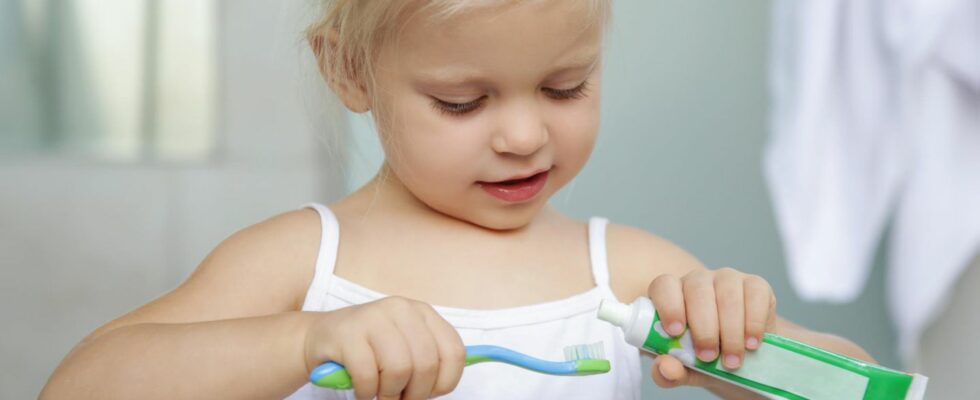titanium dioxide
Pollutant in toothpaste: what does it mean for our children?
© triocean / Adobe Stock
Brilliant white! This is not only the promise that is written on many toothpaste packaging, the paste itself is usually also pure white. The reason: the dye titanium dioxide. This has now been banned for food, but not for toothpaste. We clarify how harmful the pollutant actually is.
On February 14, 2022, the European Commission issued a ban on titanium dioxide as a food additive, which finally came into force in August last year. This means that since August 2022, manufacturers in the EU are not allowed to produce foods and dietary supplements that contain titanium dioxide. Goods that have been manufactured up to now can, however, continue to be sold until the sell-by date – even if this is in the future.
Titanium dioxide: It is now banned in food
This ban does not apply to pharmaceuticals, cosmetics or toothpaste. Here, titanium dioxide can still be used indefinitely – even in children’s toothpaste. The pollutant is usually identified on foodstuffs with the E number 171. In cosmetics or pharmaceuticals, the substance is identified using the Color Index CI 77891 or declared as “Titanium Dioxide”.
Titanium dioxide is the substance that makes toothpaste so brilliantly white or gives the pearls for the birthday cake a beautiful shine. But the dye is also used in salad dressings to make the colors appetizing. It is therefore used precisely in those places where products should be beautifully white or have a strong color. The pollutant was already banned in organic articles.
Due to the expiry date, titanium dioxide is still found in some foods today. Among other things, with sprinkles for decorating pastries, with Milka chocolate drops, with a snack called “Schulkreide”, with the dietary supplement with vitamin D3 from “Doppelherz”, the multivitamins from AZ from “Abtei” and the “taxofit” vitamin B12 plus , according to the consumer advice center Hamburg.
Titanium dioxide is said to damage the genetic material
The problem with titanium dioxide is that it is suspected to damage genetic material. At least that is the conclusion reached by the European Food Safety Authority (EFSA) in May 2021. Some studies indicate that titanium dioxide can break DNA strands and thus cause chromosome damage.
One of the problems is the particle size. In order for the titanium dioxide to develop its full power, it is usually used in a particle size of 100 to 300 nanometers. However, using such a small size again means that the particles can enter human cells.
Titanium dioxide enters the body through different routes
The pollutant enters the body via different routes. On the one hand through the digestive tract (oral). This can be through food, supplements, or medication. Titanium dioxide ingested through food is therefore no longer considered safe. On the other hand, the particles can be inhaled (by inhalation). In animal studies, deeply inhaled particles have led to chronic inflammation. At extremely high doses over a long period of time, even the development of tumors has been observed.
According to the current state of research, absorption through the skin (transdermal) is not possible. This applies to intact skin as well as skin damaged by sunburn. Titanium dioxide is therefore considered risk-free in cosmetics and sunscreen.
According to experts, toothpaste should be evaluated differently than cosmetics
According to the Hamburg consumer protection center, toothpaste should be evaluated differently. Because the mucous membranes in the mouth are structured differently than the skin. In addition, children in particular like to swallow toothpaste. In her opinion, toothpaste should therefore be viewed just as critically as food. The Federal Institute for Risk Assessment (BfR) is currently unable to assess the specific risk of toothpaste. However, a risk assessment should be carried out.
You can find a comparison of toothpaste for children here. The titanium dioxide content was also decisive.
The dye should also be allowed to continue to be used in medicines for the time being. The background is that the experts at the European Medicines Agency (EMA) fear a bottleneck in medicines. At the same time, however, the EMA underscored the need to research new alternatives. The only exception, however, are sprays, where titanium dioxide is no longer permitted.
Sources used: vzhh.de rnd.de
This article originally appeared in ELTERN.
